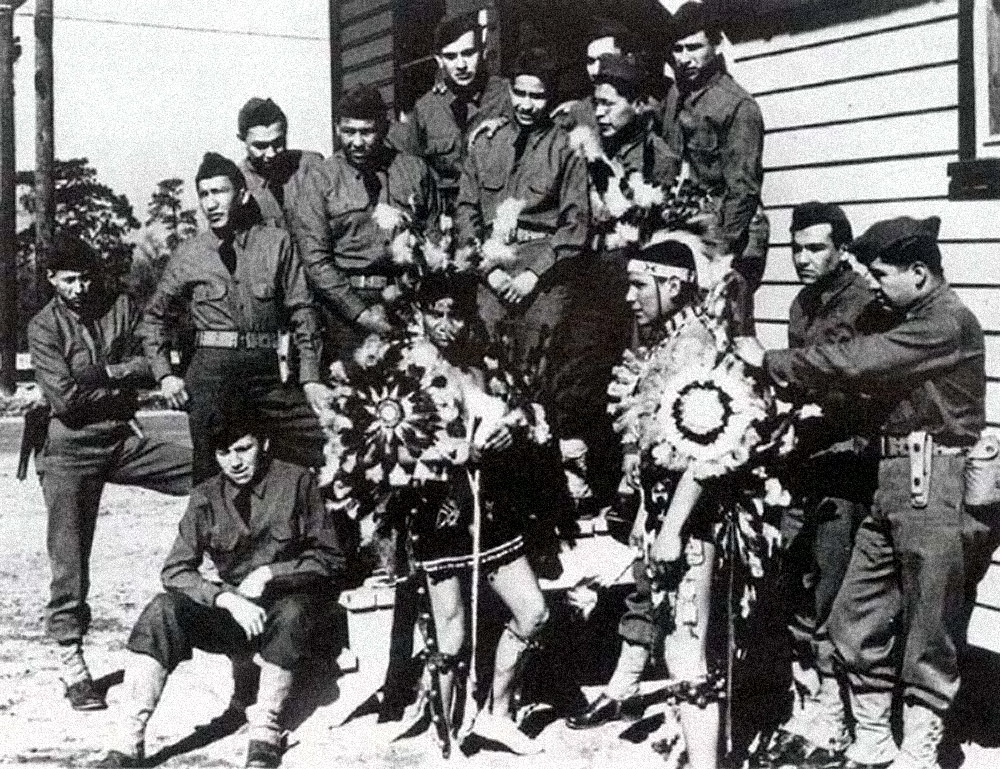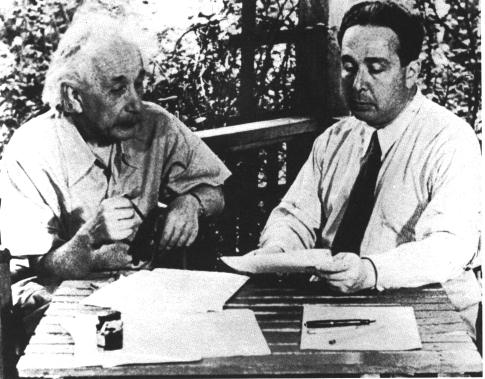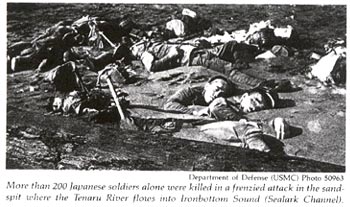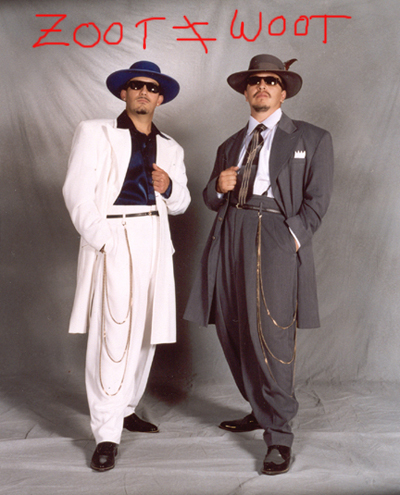 This image can be found here.
This image can be found here.This picture shows wounded men from the 3rd battalion, receiving food after they had stormed the beaches of Omaha on June 6th, 1944, the day after the originally scheduled date for D-day.
 This image can be found here.
This image can be found here.





 These are the silver and gold medals the first 29 navajo code talkers recieved in world war two.
These are the silver and gold medals the first 29 navajo code talkers recieved in world war two. This picture is a primary source, it is a image of an explosion in new mexico, and it was a very reliable source for the time. The unanwsered question was "where is it from?"
This picture is a primary source, it is a image of an explosion in new mexico, and it was a very reliable source for the time. The unanwsered question was "where is it from?"
 this picture is of albert einstien disscussing the atomic bomb and how it works and how they are going to make it. many sienentist tryed to get premission to resaerch or make an atomic bomb but none of them was sucesful until einstien came and conviced the president and secetary of war to star to construct the atomic bomb.this source is very reliable because one it is a picture and the web site is reliable.
this picture is of albert einstien disscussing the atomic bomb and how it works and how they are going to make it. many sienentist tryed to get premission to resaerch or make an atomic bomb but none of them was sucesful until einstien came and conviced the president and secetary of war to star to construct the atomic bomb.this source is very reliable because one it is a picture and the web site is reliable.

 Bazooka, also known as the M9 anti-tank Rocket Lancher. Image found here. This Bazooka came into effect in June 1943. This weapon was one of the main weapon used by the United States army.
Bazooka, also known as the M9 anti-tank Rocket Lancher. Image found here. This Bazooka came into effect in June 1943. This weapon was one of the main weapon used by the United States army.
 Atomic bomb..Or also know as a nuclear weaponry had a major
Atomic bomb..Or also know as a nuclear weaponry had a major

Before WWII this sign of the Swasticka was used for many different religions through the western world. During WWII it was used as the nazis sign and was on there flags and badges they would wear.
 This is a picture of the Swasticka trees was found outside of Berlin in 1992. They were planted by one of Hitler's followers in 1937. Swasticka trees are green then turn yellow in the fall. They were removed in 2000. This shows that even after the holocaust there was a lasting impact on the world.
This is a picture of the Swasticka trees was found outside of Berlin in 1992. They were planted by one of Hitler's followers in 1937. Swasticka trees are green then turn yellow in the fall. They were removed in 2000. This shows that even after the holocaust there was a lasting impact on the world.

This picture also represents one of the lasting impacts that the nazis and Hitler had on the world. This was built at the Coronado US nazy base in southern California around 1967. Many people debate if it was a accident or not.

 This photo about Rosie the riveter is a perimary source created in 1943 by a famous painter Norman Rockwell.On May,22,2002 Norman rockwell started painting on canvas'es. He painted all different kinds of things, but a real famous painting would be Rosie The Riveter. The peropse of this famous painting is based on the women who had to do the mens work and jobs,while the men are at war in World War ll.
This photo about Rosie the riveter is a perimary source created in 1943 by a famous painter Norman Rockwell.On May,22,2002 Norman rockwell started painting on canvas'es. He painted all different kinds of things, but a real famous painting would be Rosie The Riveter. The peropse of this famous painting is based on the women who had to do the mens work and jobs,while the men are at war in World War ll. 
 source
source
 Guadal Canal was the first island fought in the solomen island campain. in a six month period the US lost 7000 solders compard to 31000 to the japanese in pitched landl, air and sea battes.
Guadal Canal was the first island fought in the solomen island campain. in a six month period the US lost 7000 solders compard to 31000 to the japanese in pitched landl, air and sea battes.

 This photo about Rosie the riveter is a perimary source created in 1943 by a famous painter Norman Rockwell.On May,22,2002 Norman rockwell started painting on canvas'es. He painted all different kinds of things, but a real famous painting would be Rosie The Riveter. The peropse of this famous painting is based on the women who had to do the mens work and jobs,while the men are at war in World War ll.
This photo about Rosie the riveter is a perimary source created in 1943 by a famous painter Norman Rockwell.On May,22,2002 Norman rockwell started painting on canvas'es. He painted all different kinds of things, but a real famous painting would be Rosie The Riveter. The peropse of this famous painting is based on the women who had to do the mens work and jobs,while the men are at war in World War ll. 


 Some of the younger kids played "Post Office" to entertain themselves. Writing letters to Miss Breed was probably one of the reasons they had the idea to play the game. (This photo can be found HERE.)
Some of the younger kids played "Post Office" to entertain themselves. Writing letters to Miss Breed was probably one of the reasons they had the idea to play the game. (This photo can be found HERE.)These photos can be found h ere.
ere.
The pictures to the left show the hardships children had to go through while trapped at the interment camps. Many children in the camps were separated from family members and left to survive on their own. Children attended schools, that were very poorly equipt and the schools usually didn't have insulation until well after the schools were opened. One student recalled learning a whole years worth of chemistry in one week.
Children of the Camps. Satsuki Ina. 1999. Feb 28, 2008.
http://library.thinkquest.org/TQ0312008/resources.html.


 "Of course the people don't want war. But after all, it's the leaders of the country who determine the policy, and it's always a simple matter to drag the people along whether it's a democracy, a fascist dictatorship, or a parliament, or a communist dictatorship. Voice or no voice, the people can always be brought to the bidding of the leaders. That is easy. All you have to do is tell them they are being attacked, and denounce the pacifists for lack of patriotism, and exposing the country to greater danger."
"Of course the people don't want war. But after all, it's the leaders of the country who determine the policy, and it's always a simple matter to drag the people along whether it's a democracy, a fascist dictatorship, or a parliament, or a communist dictatorship. Voice or no voice, the people can always be brought to the bidding of the leaders. That is easy. All you have to do is tell them they are being attacked, and denounce the pacifists for lack of patriotism, and exposing the country to greater danger."
-- Herman Goering at the Nuremberg trials (This image can be found here.)

 These are Navy Sailors ready to quarrel with the Zoot Suits. (http://www.pbs.org/)
These are Navy Sailors ready to quarrel with the Zoot Suits. (http://www.pbs.org/) The Latino Zoot-Suit Riot
The Latino Zoot-Suit Riot
In 1943 Latinos in Los Angeles they started wearing zoot suits. Some Navy soilders got together to beat and take the zoot suits clothes and possesions. They beat anyone that was male latino or in the area at this time. 500 latinos took the blame, and were arrested. This was a very un fair event in history.
The picture to the left is from (http://beerandnews.files.wordpress.com/2006/12/zoot2.jpg) as you can see they are wearing zoot suits. Mexican-Americans were harshly discriminated against; some sailors would beat them up and take their suits. People in zoot suits were thought of as gangsters.
 This photograph is of Teenagers during the Zoot suit riots. (http://www.pro.corbis.com/)
This photograph is of Teenagers during the Zoot suit riots. (http://www.pro.corbis.com/)
